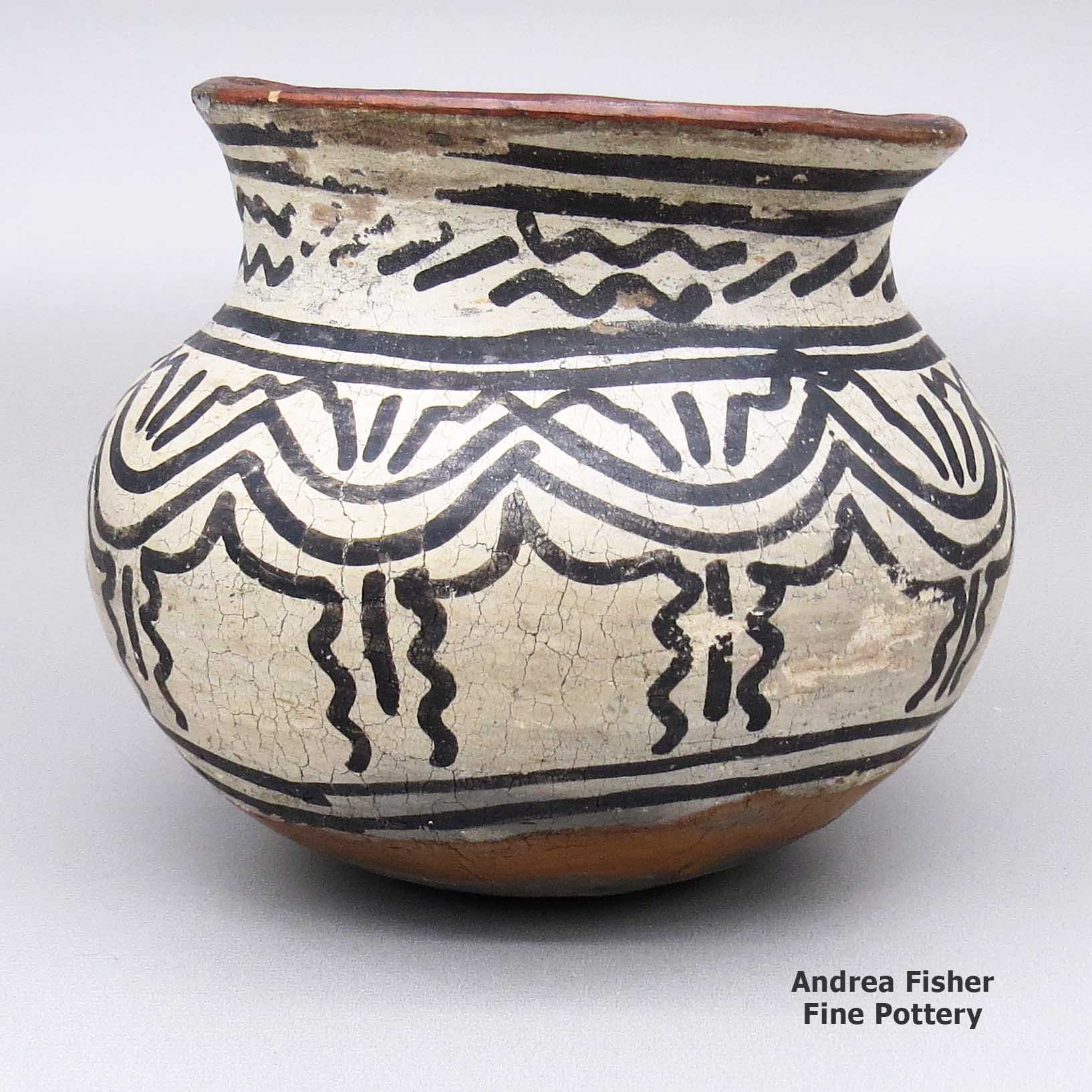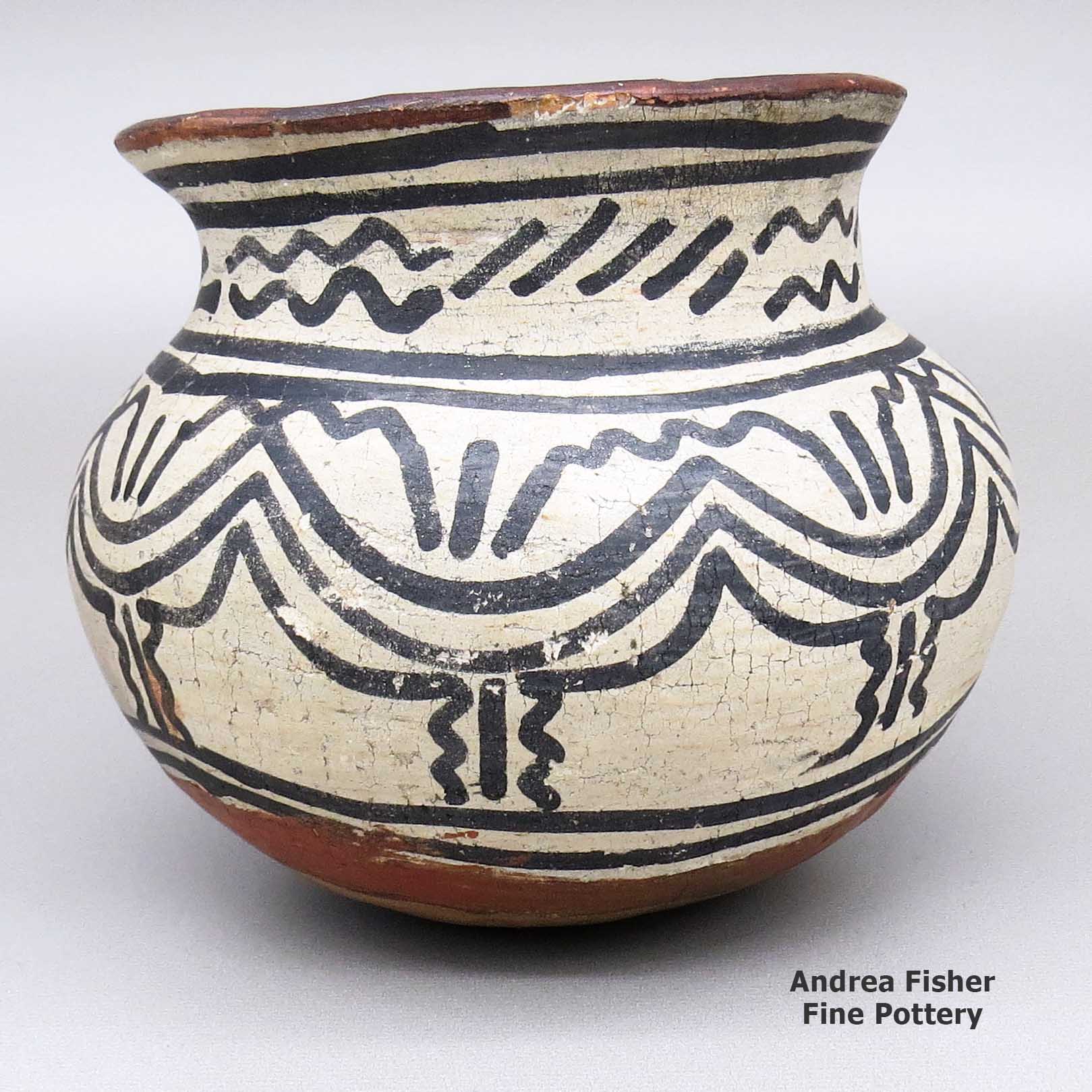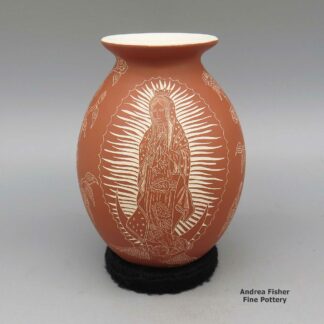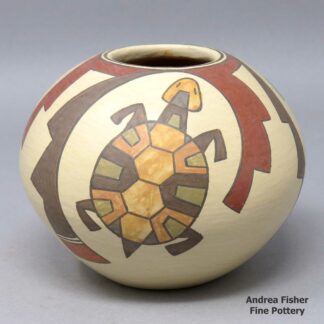| Dimensions | 5.5 × 5.5 × 5 in |
|---|---|
| Condition of Piece | Good, has small chips on rim and heavy wear overall |
Unknown Tesuque Potter, zzte3b563, Polychrome jar with a geometric design
$1,100.00
A polychrome jar with a flared opening and decorated with a geometric design
In stock
Brand
Unknown Tesuque Potter
A Short History of Tesuque Pueblo

Tesuque Pueblo is located about 10 miles north of today's city of Santa Fe, New Mexico. Archaeologists have dated a few sites in the Tesuque Valley back to about 850 CE. By 1200 CE there were many small villages in the area but when the Spanish arrived in 1540, they found only six villages left. The main Tesuque Pueblo (at that time) was located about 3 miles east of today's pueblo.
During the Pueblo Revolt of 1680, it was a pair of Tesuque runners who misled the Spanish as to when the tribes planned to revolt. The Spanish governor killed the runners for their efforts, then saw many of his Spanish subjects killed when it turned out the "date" their torturing of the runners had gotten them was wrong and the tribes revolted before that.
At Tesuque the warriors killed the local priest and another government official immediately, then marched to the Palace of the Governors in Santa Fe to join with the warriors of other pueblos in that confrontation with the Spanish. A few days later, the Spanish were allowed to leave the Palace of the Governors peacefully and begin the long march south on the Camino Real back to Mexico.
When Don Diego de Vargas returned at the head of Spanish troops (the Conquistadors) in 1692 and began to reconquer northern Nuevo Mexico, one of the first things he had his men do was tear down and burn the main Tesuque village. The tribe quickly officially submitted to Spanish rule, moved to the present pueblo site and began rebuilding in 1694.
Between changes of government, European-introduced diseases, European encroachment on pueblo land and general disregard for the people of the pueblos, the next 200 years were not kind to the Tesuque people and by 1910 the pueblo's population was down to 77.
Today there are about 800 members of the Tesuque tribe living on a reservation of more than 17,000 acres. Among several other businesses, the tribe operates the Tesuque Casino (next to the Santa Fe Opera) and the Camel Rock Suites (on South St. Francis Drive in Santa Fe).
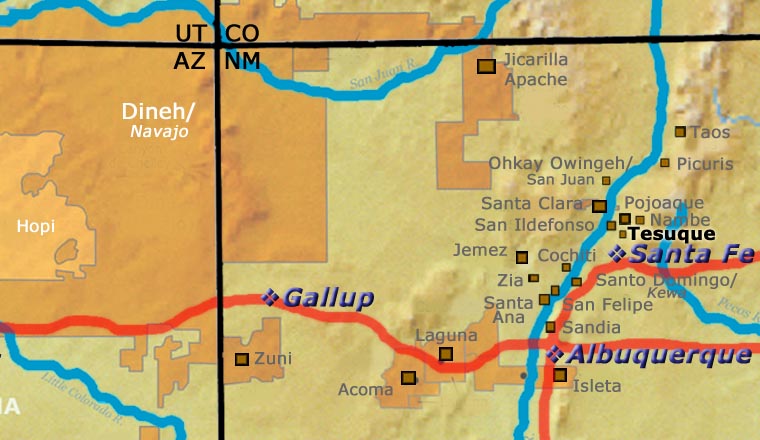
For more info:
Pueblos of the Rio Grande, Daniel Gibson, ISBN-13:978-1-887896-26-9, Rio Nuevo Publishers, 2001
About Jars
The jar is a basic utilitarian shape, a container generally for cooking food, storing grain or for carrying and storing water. The jar's outer surface is a canvas where potters have been expressing their religious visions and stories for centuries.
In Sinagua pueblos (in northern Arizona), the people made very large jars and buried them up to their openings in the floors of the hidden-most rooms in their pueblo. They kept those jars filled with water but also kept smaller jars of meat and other perishables inside those jars in the water. It's a form of refrigeration still in use among indigenous people around the world.
Where bowls tend to be low, wide and with large openings, jars tend to be more globular: taller, less wide and with smaller openings.
For a potter looking at decorating her piece, bowls are often decorated inside and out while most jars are decorated only on the outside. Jars have a natural continuity to their design surface where bowls have a natural break at the rim, effectively yielding two design surfaces on which separate or complimentary stories can be told.
Before the mid-1800s, storage jars tended to be quite large. Cooking jars and water jars varied in size depending on how many people they were designed to serve. Then came American traders with enameled metal cookware, ceramic dishes and metal eating utensils...Some pueblos embraced those traders immediately while others took several generations to let them and their innovations in. Either way, opening those doors led to the virtual collapse of utilitarian pottery-making in most pueblos by the early 1900s.
In the 1920s there was a marked shift away from the machinations of individual traders and more toward marketing Native American pottery as an artform. Maria Martinez was becoming known through her exhibitions at various major industrial fairs around the country and Nampeyo of Hano was demonstrating her art for the Fred Harvey Company at the Grand Canyon. The first few years of the Santa Fe Indian Market helped to solidify that movement and propel it forward. It took another couple generations of artists to open other venues for their art across the country and turn Native American art into the phenomenon it has become.
Today's jars are artwork, not at all for utilitarian purposes, and their shapes, sizes and decorations have evolved to reflect that shift.
About Geometric Designs
"Geometric design" is a catch-all term. Yes, we use it to denote some kind of geometric design but that can include everything from symbols, icons and designs from ancient rock art to lace and calico patterns imported by early European pioneers to geometric patterns from digital computer art. In some pueblos, the symbols and patterns denoting mountains, forest, wildlife, birds and other elements sometimes look more like computer art that has little-to-no resemblance to what we have been told they symbolize. Some are built-up layers of patterns, too, each with its own meaning.
"Checkerboard" is a geometric design but a simple black-and-white checkerboard can be interpreted as clouds or stars in the sky, a stormy night, falling rain or snow, corn in the field, kernels of corn on the cob and a host of other things. It all depends on the context it is used in, and it can have several meanings in that context at the same time. Depending on how the colored squares are filled in, various basket weave patterns can easily be made, too.
"Cuadrillos" is a term from Mata Ortiz. It denotes a checkerboard-like design using tiny squares filled in with paints to construct larger patterns.
"Kiva step" is a stepped geometric design pattern denoting a path into the spiritual dimension of the kiva. "Spiral mesa" is a similar pattern, although easily interpreted with other meanings, too. The Dineh have a similar "cloud terrace" pattern.
That said, "geometric designs" proliferated on Puebloan pottery after the Spanish, Mexican and American settlers arrived with their European-made (or influenced) fabrics and ceramics. The newcomers' dinner dishes and printed fabrics contributed much material to the pueblo potters design palette, so much and for so long that many of those imported designs and patterns are considered "traditional" now.

